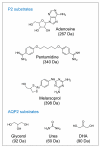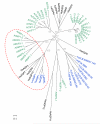Drug resistance in African trypanosomiasis: the melarsoprol and pentamidine story
- PMID: 23375541
- PMCID: PMC3831158
- DOI: 10.1016/j.pt.2012.12.005
Drug resistance in African trypanosomiasis: the melarsoprol and pentamidine story
Abstract
Melarsoprol and pentamidine represent the two main classes of drugs, the arsenicals and diamidines, historically used to treat the diseases caused by African trypanosomes: sleeping sickness in humans and Nagana in livestock. Cross-resistance to these drugs was first observed over 60 years ago and remains the only example of cross-resistance among sleeping sickness therapies. A Trypanosoma brucei adenosine transporter is well known for its role in the uptake of both drugs. More recently, aquaglyceroporin 2 (AQP2) loss of function was linked to melarsoprol-pentamidine cross-resistance. AQP2, a channel that appears to facilitate drug accumulation, may also be linked to clinical cases of resistance. Here, we review these findings and consider some new questions as well as future prospects for tackling the devastating diseases caused by these parasites.
Copyright © 2013 Elsevier Ltd. All rights reserved.
Figures




Similar articles
-
Melarsoprol Resistance in African Trypanosomiasis.Trends Parasitol. 2018 Jun;34(6):481-492. doi: 10.1016/j.pt.2018.04.002. Epub 2018 Apr 25. Trends Parasitol. 2018. PMID: 29705579 Review.
-
Positively selected modifications in the pore of TbAQP2 allow pentamidine to enter Trypanosoma brucei.Elife. 2020 Aug 11;9:e56416. doi: 10.7554/eLife.56416. Elife. 2020. PMID: 32762841 Free PMC article.
-
Arsenicals (melarsoprol), pentamidine and suramin in the treatment of human African trypanosomiasis.Parasitol Res. 2003 May;90(1):71-9. doi: 10.1007/s00436-002-0799-9. Epub 2003 Jan 31. Parasitol Res. 2003. PMID: 12743807 Review.
-
Melarsoprol sensitivity profile of Trypanosoma brucei gambiense isolates from cured and relapsed sleeping sickness patients from the Democratic Republic of the Congo.PLoS Negl Trop Dis. 2014 Oct 2;8(10):e3212. doi: 10.1371/journal.pntd.0003212. eCollection 2014 Oct. PLoS Negl Trop Dis. 2014. PMID: 25275572 Free PMC article.
-
Aquaglyceroporin 2 controls susceptibility to melarsoprol and pentamidine in African trypanosomes.Proc Natl Acad Sci U S A. 2012 Jul 3;109(27):10996-1001. doi: 10.1073/pnas.1202885109. Epub 2012 Jun 18. Proc Natl Acad Sci U S A. 2012. PMID: 22711816 Free PMC article.
Cited by
-
Probing the binding and antiparasitic efficacy of azobenzene G-quadruplex ligands to investigate G4 ligand design.Chem Commun (Camb). 2024 Oct 8;60(81):11520-11523. doi: 10.1039/d4cc03106g. Chem Commun (Camb). 2024. PMID: 39308448 Free PMC article.
-
An in-depth exploration of the multifaceted roles of EVs in the context of pathogenic single-cell microorganisms.Microbiol Mol Biol Rev. 2024 Sep 26;88(3):e0003724. doi: 10.1128/mmbr.00037-24. Epub 2024 Jun 13. Microbiol Mol Biol Rev. 2024. PMID: 38869292 Review.
-
Structural insights into drug transport by an aquaglyceroporin.Nat Commun. 2024 May 11;15(1):3985. doi: 10.1038/s41467-024-48445-4. Nat Commun. 2024. PMID: 38734677 Free PMC article.
-
Drug resistance in animal trypanosomiases: Epidemiology, mechanisms and control strategies.Int J Parasitol Drugs Drug Resist. 2024 Aug;25:100533. doi: 10.1016/j.ijpddr.2024.100533. Epub 2024 Mar 30. Int J Parasitol Drugs Drug Resist. 2024. PMID: 38555795 Free PMC article. Review.
-
Lead Optimization of the 5-Phenylpyrazolopyrimidinone NPD-2975 toward Compounds with Improved Antitrypanosomal Efficacy.J Med Chem. 2024 Feb 22;67(4):2849-2863. doi: 10.1021/acs.jmedchem.3c01976. Epub 2024 Feb 8. J Med Chem. 2024. PMID: 38330051 Free PMC article.
References
-
- Ehrlich P. Chemotherapeutische Trypanosomen-Studien. Berliner klinische Wochenschrift. 1907;9:233–236.
-
- Wastling SL, Welburn SC. Diagnosis of human sleeping sickness: sense and sensitivity. Trends Parasitol. 2011;27:394–402. - PubMed
-
- Priotto G, et al. Nifurtimox-eflornithine combination therapy for second-stage African Trypanosoma brucei gambiense trypanosomiasis: a multicentre, randomised, phase III, non-inferiority trial. Lancet. 2009;374:56–64. - PubMed
-
- Simarro PP, et al. Update on field use of the available drugs for the chemotherapy of human African trypanosomiasis. Parasitology. 2012;139:842–846. - PubMed
Publication types
MeSH terms
Substances
Grants and funding
LinkOut - more resources
Full Text Sources
Other Literature Sources

